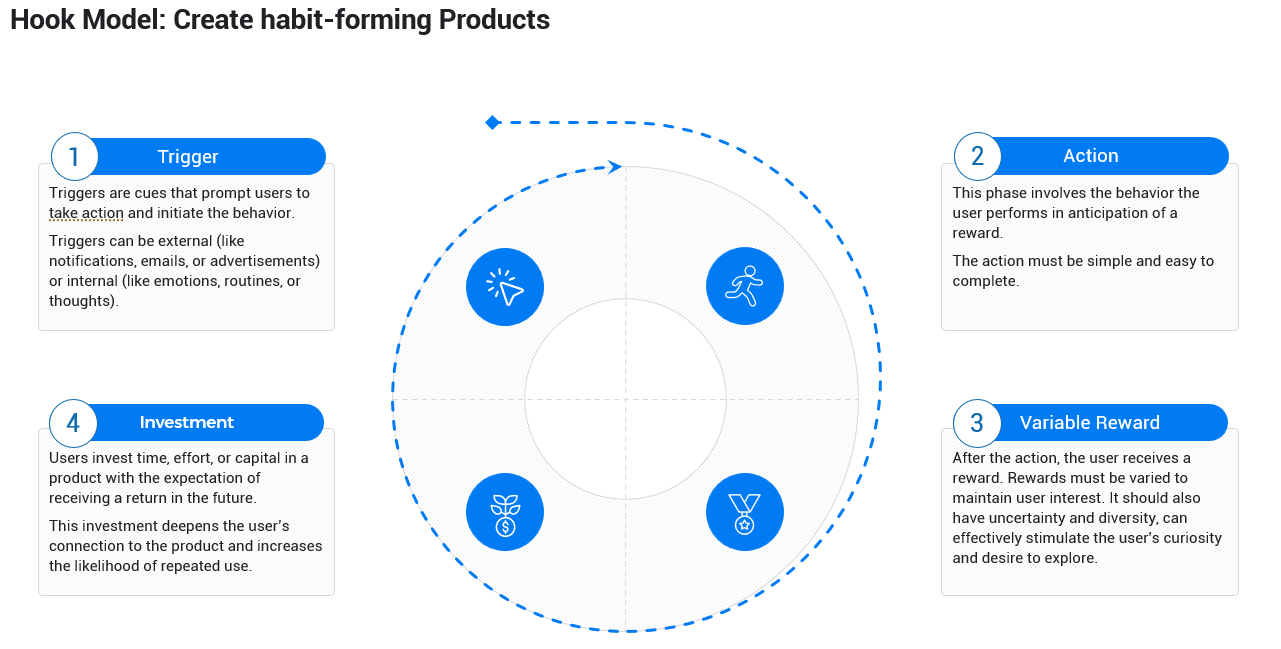A four-phase loop of Trigger, Action, Variable Reward, and Investment for habit-forming products.
Why This Matters
In a crowded digital world, many products struggle to hold user attention. Users often try something once and move on. A strong engagement loop is essential for user retention and long-term success.
The Hook Model helps designers and product teams identify how to build habit-forming products that bring people back again and again. By combining this model with system thinking, you can see not just features but the whole system of triggers, rewards, and investments that sustain habits.
What is Hook Model?
The Hook Model is a psychological framework developed by Nir Eyal.
It is designed to explain how companies can create habit-forming products that capture and sustain users' attention.
Outlined in his book "Hooked: How to Build Habit-Forming Products," the model consists of a four-phase cycle that fosters user engagement and promotes habit formation.
The Four Phases of the Hook Model
Trigger
Triggers are cues that prompt users to take action, and initiate the behavior.
Triggers can be external (like notifications, emails, or advertisements) or internal (like emotions, routines, or thoughts).
Over time, external triggers aim to create internal triggers, making the behavior more automatic.
Internal triggers are particularly powerful because they create a habitual response.
Example: A push notification from a social media app might remind a user to check for updates, while boredom can become an internal trigger to open the app without prompting.
Action
This phase involves the behavior the user performs in anticipation of a reward.
The action must be simple and easy to complete.
For this to happen, the user needs both motivation and the ability to perform the action with minimal friction.
Example: Scrolling through a social media feed or clicking on a video link are actions designed to be frictionless.
Variable Reward
After the action, the user receives a reward.
Rewards must be varied to maintain user interest.
The key is that the reward must be variable, not predictable, because the "Predictable Rewards" quickly become mundane, but "Variable Rewards" keep users engaged by offering an element of surprise or novelty.
This variability creates a sense of anticipation and excitement, similar to gambling, which keeps users engaged and coming back for more.
"Gamification" can be introduced to delight your users.
Examples include social validation (likes, comments), content (new videos, articles), or personal achievement (leveling up in a game).
Investment
In this final step, users are asked to invest something of value into the product (time, data, effort, money, etc.).
This investment increases the likelihood of future engagement because it creates a sense of commitment and ownership.
The more users invest, the more they value the product, leading to a deeper habit formation.
Examples:
More and more friends were connected in Fackbook, and the interaction with others became more and more frequent.
In computer games, the level, equipment and skills of your character continue to increase.
Creating playlists, or contributing content to a community
Why Hook?
The metaphor of a "hook" is used because it symbolizes the mechanism that catches hold of users and encourages them to return repeatedly.
Capturing Attention
Just like a fish hook captures a fish, the Hook Model is designed to capture the user's attention through triggers.
These triggers initiate the cycle of engagement, making users notice and engage with the product.
Habit Formation
The "hook" analogy reflects the idea of getting users "hooked" on the product.
The model's design ensures that users develop a habit around using the product, much like how a hook keeps hold of a fish.
Repetition and Engagement
The Hook Model emphasizes creating a loop that users go through repeatedly: Trigger, Action, Variable Reward, and Investment.
This repetitive process ensures ongoing engagement, akin to a hook that keeps bringing the fish back.
Tips of Using Hook Model
- Simplify Actions: Make the desired action as easy as possible. Optimize the user interface and experience to reduce friction.
- Balance Rewards: Keep rewards meaningful yet unpredictable to maintain user interest.
- Incentivize Investments: Ensure that investments, such as time and effort, offer users tangible value and foster future engagement.
- Leverage Data: Use analytics to monitor user behavior, refine the feedback loop, and enhance engagement and retention.
Template
Get into the real practice now.






